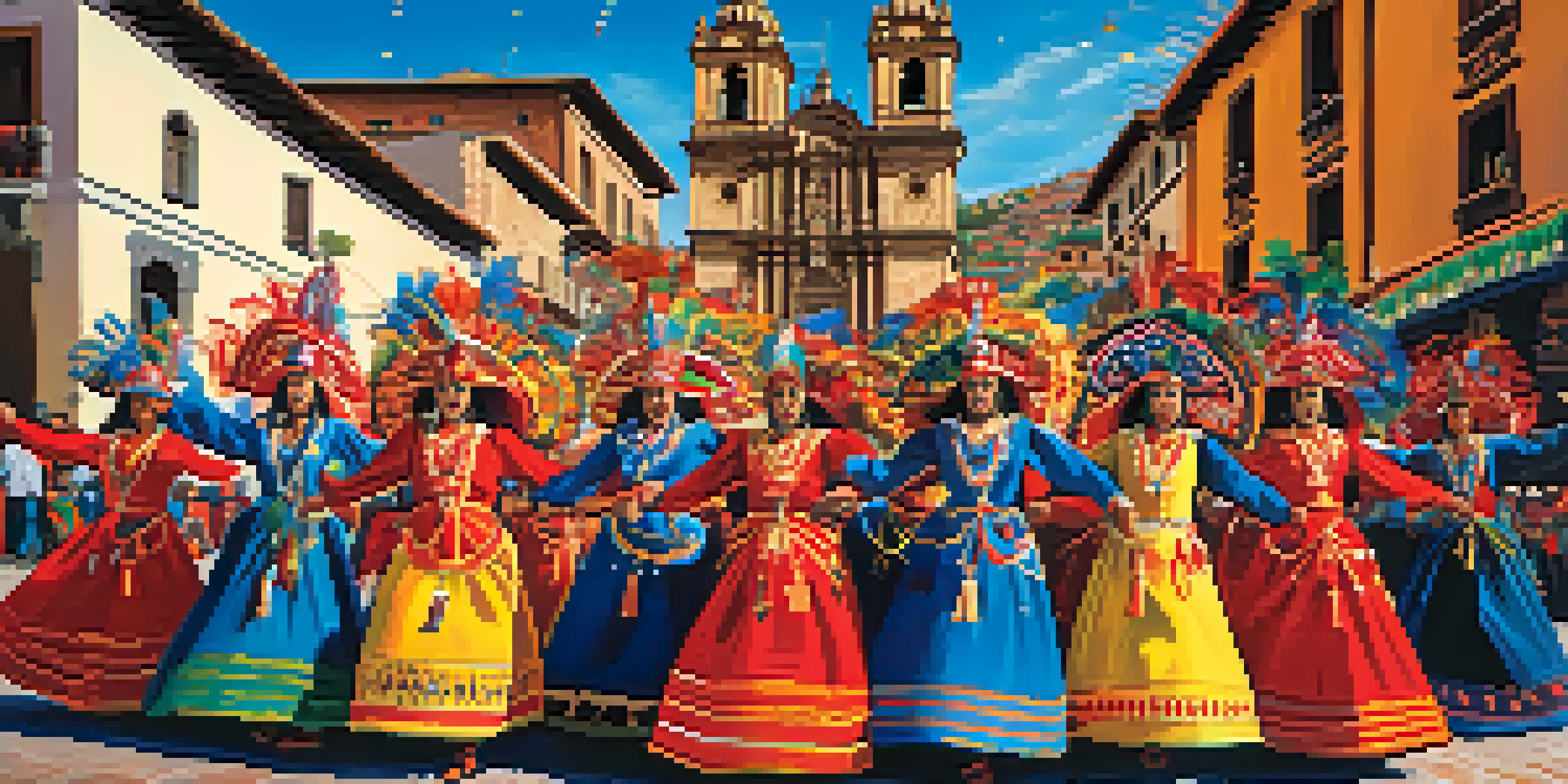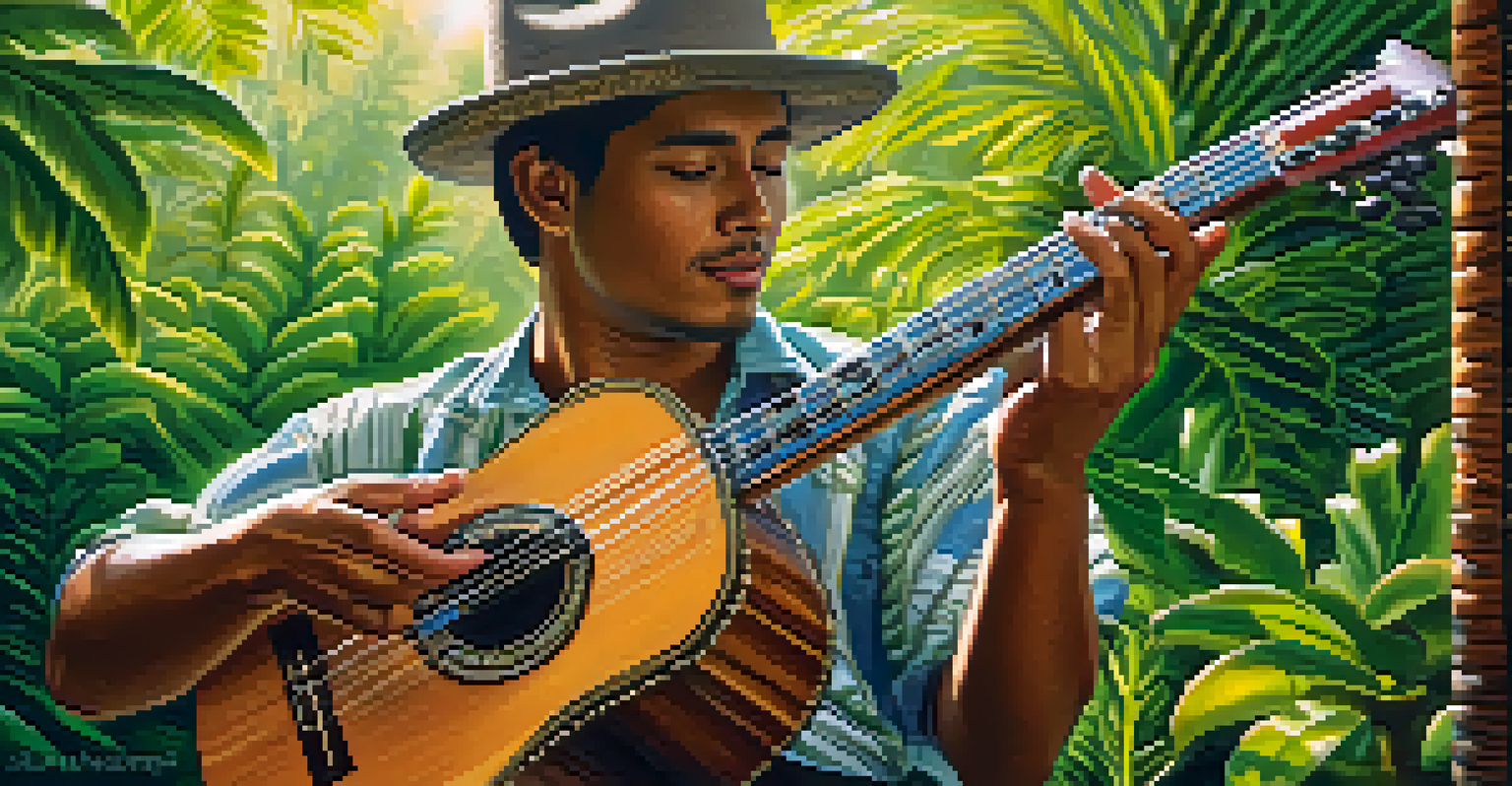The Influence of Indigenous Music in Peruvian Festivals

The Roots of Indigenous Music in Peru
Indigenous music in Peru has deep historical roots, tracing back to ancient civilizations like the Incas. These cultures used music not just for entertainment, but as a vital part of rituals and ceremonies that connected them to their beliefs and the natural world. Traditional instruments like the charango and pan flute still resonate in today’s festivals, echoing the sounds of a rich heritage.
Music is the shorthand of emotion.
The melodies and rhythms of Indigenous music tell stories of the land, people, and their struggles. This music often reflects the spiritual connection between the community and their environment, showcasing themes of nature, life, and ancestral wisdom. For instance, many songs are performed during agricultural festivals to honor Pachamama, or Mother Earth, highlighting the importance of sustainability and respect for nature.
As Peru evolved, so did its music, blending Indigenous sounds with Spanish influences. However, the core of Indigenous music remains intact and continues to thrive within various cultural celebrations. This fusion creates a unique soundscape that invites both locals and tourists to experience the vibrant culture of Peru during its festivals.
Key Instruments in Indigenous Peruvian Music
Indigenous Peruvian music is defined by its unique instruments, each with a story to tell. The charango, a small stringed instrument made from the shell of an armadillo, produces a bright, cheerful sound that’s often heard during festive gatherings. The pan flute, or siku, made from bamboo tubes, creates haunting melodies that evoke a deep sense of connection to the Andean landscape.

Another important instrument is the bombo, a large drum that provides the rhythmic foundation for many traditional dances and celebrations. This drum is often played in sync with the energetic footwork of dancers, amplifying the vibrant atmosphere of festivals. Together, these instruments create a rich tapestry of sound that captures the essence of Indigenous culture.
Indigenous Music's Cultural Significance
Indigenous music in Peru serves as a vital connection to heritage, spirituality, and community identity.
The skill and artistry involved in playing these instruments have been passed down through generations. Musicians often learn from their elders, ensuring that the traditions remain alive and evolving. During festivals, you can often see these musicians not just performing, but sharing their passion and stories with the crowd, making the experience all the more immersive.
Festivals Celebrating Indigenous Heritage
Peru is home to numerous festivals that celebrate Indigenous music and culture, with Inti Raymi being one of the most famous. This festival, held in June, honors the Incan sun god and features traditional music, dance, and colorful costumes. The event attracts thousands of visitors, eager to witness the revival of ancient traditions amidst the stunning backdrop of Cusco.
The roots of music are deep and complex, intertwined with the cultural identity of communities.
Another significant festival is the Virgen de la Candelaria in Puno, recognized as a UNESCO Intangible Cultural Heritage. This event showcases a vibrant mix of Indigenous music and dance, where traditional instruments take center stage. The festival is a powerful display of cultural identity, allowing communities to express their history and spirituality through music.
These festivals not only celebrate Indigenous heritage but also foster community spirit and pride. They serve as a reminder of the resilience of Indigenous cultures in the face of modern challenges. Through music, these communities strengthen their identity and pass on their rich traditions to future generations.
The Role of Dance in Peruvian Festivals
Dance is an integral part of Indigenous music in Peruvian festivals, bringing the music to life in an expressive way. Each dance tells a story, often representing historical events, cultural narratives, or natural phenomena. The synchronization of music and dance creates a vibrant atmosphere that captivates audiences and invites participation.
For instance, the Diablada dance, performed during the Carnaval de Oruro, showcases both the music and the colorful costumes of the dancers. This dance tells the story of the struggle between good and evil, embodying the spiritual beliefs of the Indigenous people. The lively music accompanying the dance enhances the storytelling, making it an unforgettable experience for attendees.
Festivals Celebrate Musical Traditions
Peruvian festivals like Inti Raymi and Virgen de la Candelaria showcase Indigenous music, dance, and cultural pride.
Moreover, dance serves as a communal activity that strengthens social bonds within the community. It provides an opportunity for people of all ages to come together, share their cultural practices, and celebrate their identity. Through dance, the younger generations learn about their heritage while keeping the music alive in a fun and engaging way.
Modern Influences on Indigenous Music
While Indigenous music remains rooted in tradition, it has also embraced modern influences, creating exciting new genres. Artists incorporate contemporary styles, such as pop and rock, while still honoring traditional sounds and themes. This fusion not only attracts younger audiences but also helps to keep Indigenous music relevant in today’s world.
For example, artists like Susana Baca have gained international acclaim by blending Afro-Peruvian rhythms with modern music, showcasing the versatility of Indigenous sounds. Such innovations allow musicians to express contemporary issues while staying connected to their roots. This evolution of music reflects the dynamic nature of culture, which continues to adapt over time.
Modern technology has also played a significant role in promoting Indigenous music. Social media platforms enable artists to reach global audiences, sharing their music and stories far beyond their local communities. This exposure not only celebrates Indigenous heritage but also encourages cross-cultural exchange, fostering a deeper appreciation for Peru's diverse musical landscape.
The Impact of Indigenous Music on Cultural Identity
Indigenous music plays a crucial role in shaping cultural identity among Peruvians, fostering a sense of belonging and pride. For many communities, music is a way to connect with their history and traditions, reinforcing their unique cultural narratives. This connection to music helps individuals understand their place within the larger tapestry of Peruvian society.
Moreover, music serves as a vehicle for social commentary, allowing Indigenous communities to voice their concerns and aspirations. Through lyrics and performances, musicians highlight issues such as land rights, environmental protection, and cultural preservation. This aspect of Indigenous music makes it a powerful tool for advocacy and change.
Modern Influences Shape Indigenous Sound
Contemporary artists blend traditional Indigenous music with modern styles, keeping the genre relevant and engaging for new audiences.
By participating in festivals and performances, people not only celebrate their heritage but also assert their identity in a rapidly changing world. The preservation of Indigenous music and its influence on cultural identity is essential for maintaining the richness and diversity of Peru’s cultural landscape.
Preserving Indigenous Music for Future Generations
Preserving Indigenous music is vital for maintaining cultural heritage in Peru, especially as globalization continues to influence local traditions. Communities are increasingly aware of the need to document and teach their music to younger generations. This commitment ensures that the stories and sounds of their ancestors continue to resonate in the future.
One approach to preservation involves educational programs that teach traditional music and dance in schools. These initiatives not only instill pride in cultural identity but also provide opportunities for youth to engage creatively. By learning their musical heritage, they become ambassadors of their culture, sharing it with the world.

Additionally, festivals play an essential role in keeping Indigenous music alive. They serve as platforms for artists to showcase their talents and connect with audiences. Through participation in these events, communities reinforce their cultural traditions while adapting them to modern contexts, creating a vibrant and evolving musical landscape.